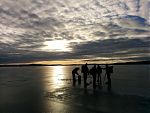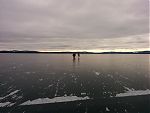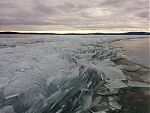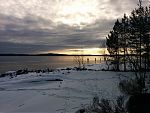20. Februar 2015
Long distance ice skating on Siljan: Old places, new adventures
 The ice conditions and the weather in Stockholm being far from ideal for ice-skating, we travelled all the way up to Lake Siljan in Dalarna, Sweden. An essay on the wonders of long-distance ice-skating, a winter activity as fantastic as well as little known outside the Nordic countries.
The ice conditions and the weather in Stockholm being far from ideal for ice-skating, we travelled all the way up to Lake Siljan in Dalarna, Sweden. An essay on the wonders of long-distance ice-skating, a winter activity as fantastic as well as little known outside the Nordic countries.
It is interesting that certain sports just seem to remain in the niche. This seems to be particularly true for Nordic skating, or long distance ice skating as one may call it. Very few people, including myself for a long time, are not even aware of its existence. Ice skating is often associated with going around in circles on an indoor ice rink with music from the 70s. But then there is so much more to it when it comes when speeding over the ice of frozen wild lakes or over the salt ice on sheltered coastal areas.
By taking ice skating to the outdoors (where it probably started anyway), you get a lot of benefits over the potentially monotonous joys of an ice rink. The scenery can be breathtaking, you can reach higher speeds, navigation and pathfinding over the potentially treacherous ice adds to the experience, and there are fantastic people to meet. It is simply addictive.
Addictive as it is, I went ice skating this winter as well. The weather and ice conditions around Stockholm, however, were unfortunately adverse, and we therefore made a trip from Stockholm up to Lake Siljan. The very same place which served us as a bathing place one summer now become the starting point of a 50 km ice skating trip across the frozen lake, hopefully without any bathing this time.
But before diving into the details of the trip, it is worth taking a step back andbuildings wondering about why ice skating is possible at all. The explanation is given by physics. As Mårten Ajne states so concisely in his almanac on the topic of long distance ice skating, if it weren’t for the interesting property of ice having less density than water, then ice would not float. Furthermore, fresh water has its highest density at 4° C, which does not only have implications on life in the water, but is also of interest for ice skaters. And these aspects are just the tip of the iceberg: the formation of ice under various conditions is a worthwhile topic to study by itself.
Back to the trip on Siljan. The conditions were favorably enough for a lake like Siljan to freeze. Now, I wrote that we were covering 50 km on this trip on a single day. However, the friction on ice is low, and ice skating is a surprisingly efficient way of covering distance without mechanical translation like the one a bicycle provides. This way, the trip allowed us to enjoy the scenery at the same time. It is impressive: a flat area of ice, reflecting the light from the sky – completely empty apart from a handful of ice skaters and ice anglers.
There are dangers of ice skating in the wilderness. I usually get asked about these, and my reply is usually yes and no. It is sufficiently risky to make diligent preparation, complete equipment, and previous knowledge mandatory. I remember that I once saw a woman and a child walking on ice on the frozen Baltic sea within the Stockholm archipelago. Without any equipment, and without anyone else in sight. This is the wrong way and very irresponsible. This as a reminder to any casual readers to do your homework.
We were particularly lucky on our ice skating trip on Lake Siljan. The ice was hard and the surface smooth and even for the most parts of the journey. Towards the end of the trip, we saw an ice shove. The force is strong with the ice! Such ice can actually pose a real danger to buildings close to the shoreline, as ice in winter can be pressed a surprisingly long way onto the shore.
Ice skating in the wild. It really is a wonderful winter activity, and a winter activity less popular than skiing. However, besides favorably weather coonditions and some water to freeze, it is also less expensive, and less crowded. I have travelled over 550 km on ice (which is nothing compared to a seasoned ice skater) and I hope that there will be many more kilometers in future. If you are given a chance to try long distance ice skating, I urge you to give it a chance.
Concluding, I want to thank my extraordinary friend S. in Sweden who made this trip possible. Also, I am grateful for all the other ice skaters who were good company and always eager to give me useful hints to improve my technique. Ett stort tack.


